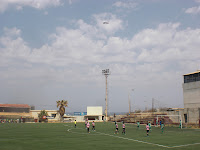The inside of Atatürk International Airport gives flashbacks of a snow drifted winter day spent wandering its departure lounges, the sky outside pitch-black throughout, in my memory at least. A day before I knew Lebanon, Beirut and the good friends and countless unforgettable days and small details of the last five and a half months. Arriving here earlier, I walked past the transit passenger helpdesk where I had taken part in a scramble of angry passengers rearranging snowed-off flights. Today there was nobody there. I walked to the window at the bottom of the slope in front of the main departures notice board. Where before, visibility did not extend beyond the grainy grounded Boeing 737s, today I could see all the way past the green trees at the airport boundary and to the sea.
Sitting opposite a restaurant where I wrote my first blog post away from home, I watched people of every conceivable race and appearance float by. Tanned Koreans, women in full niqab, blonde Dutch children, Saudis, formal Brits, Indians in saris, Rastafarians, hipsters, airport retail staff on rollerskates. I'm surrounded by the world, but it remains impenetrable as I sit in silence.
The lights went out on my last day in Lebanon. With my quarter plunged into an indefinite power blackout by the Lebanese electricity provider, I spent no small effort mopping water from our apartment floor after rescuing my soaking clothes from the stricken washing machine. Once the rush was over, I crammed my things into my backpack and said goodbye to my flatmates and Fustu. As I picked the little cat up, he stretched forward and gave me a playful bite on the nose. I felt a tear in my eye.
I left the apartment and hailed a taxi on the street outside. Blaming "aj'ah", traffic jams, the driver took a route I'd never seen before. Dawra, Achrafieh, Sin el-Fil and Furn ech-Chebbak all slipped past. He turned down a dusty sliproad, from where you could see back across the city from a slightly elevated position, before finally coming down on to the old airport road with its big mosques and concrete shack-like stores and restaurants. A blue sign saying 'Thankyou for visiting Bourj al-Barajneh' marked the end of the journey through town as the taxi entered the airport complex.
After take-off the plane banked sharply to the right and flew almost parallel to the Corniche for a while. I could make out al-Raouché/Pigeon Rocks and even the lighthouse and the concrete promontory of the al-Manara restaurant behind it. Before long the atmospheric haze of the Middle Eastern summer afternoon finally blurred out the Lebanese coastline and mountain range beyond.
Sitting opposite a restaurant where I wrote my first blog post away from home, I watched people of every conceivable race and appearance float by. Tanned Koreans, women in full niqab, blonde Dutch children, Saudis, formal Brits, Indians in saris, Rastafarians, hipsters, airport retail staff on rollerskates. I'm surrounded by the world, but it remains impenetrable as I sit in silence.
The lights went out on my last day in Lebanon. With my quarter plunged into an indefinite power blackout by the Lebanese electricity provider, I spent no small effort mopping water from our apartment floor after rescuing my soaking clothes from the stricken washing machine. Once the rush was over, I crammed my things into my backpack and said goodbye to my flatmates and Fustu. As I picked the little cat up, he stretched forward and gave me a playful bite on the nose. I felt a tear in my eye.
I left the apartment and hailed a taxi on the street outside. Blaming "aj'ah", traffic jams, the driver took a route I'd never seen before. Dawra, Achrafieh, Sin el-Fil and Furn ech-Chebbak all slipped past. He turned down a dusty sliproad, from where you could see back across the city from a slightly elevated position, before finally coming down on to the old airport road with its big mosques and concrete shack-like stores and restaurants. A blue sign saying 'Thankyou for visiting Bourj al-Barajneh' marked the end of the journey through town as the taxi entered the airport complex.
After take-off the plane banked sharply to the right and flew almost parallel to the Corniche for a while. I could make out al-Raouché/Pigeon Rocks and even the lighthouse and the concrete promontory of the al-Manara restaurant behind it. Before long the atmospheric haze of the Middle Eastern summer afternoon finally blurred out the Lebanese coastline and mountain range beyond.


















































